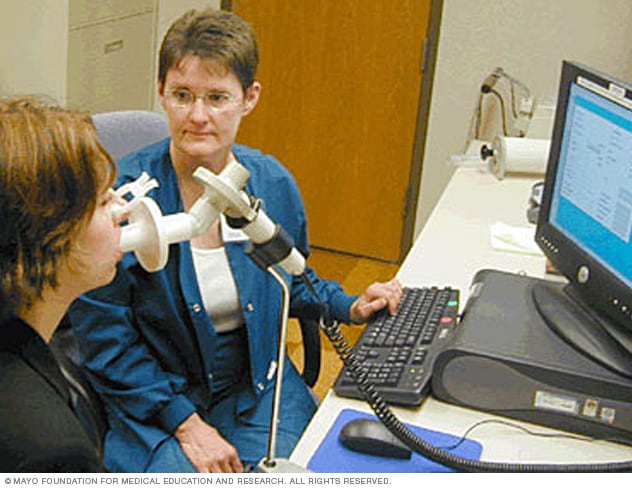Overview
Spirometry (spy-ROM-uh-tree) is a common test used to check how well your lungs work. It measures how much air you breathe in, how much you breathe out and how quickly you breathe out.
Healthcare professionals use spirometry to diagnose asthma, chronic obstructive pulmonary disease (COPD) and other conditions that affect the ability to breathe. Healthcare professionals also may use spirometry from time to time to check the condition of your lungs and see whether a treatment for a lifelong lung condition is helping you breathe better.
Products & Services
Why it's done
If your healthcare professional thinks your symptoms may be caused by a lung condition such as asthma, COPD, chronic bronchitis, emphysema or pulmonary fibrosis, you may be asked to get a spirometry test. If you've already been diagnosed with a lung condition, your healthcare professional may use spirometry from time to time to check how well your medicines are working and whether your breathing problems are under control.
Your healthcare professional can order spirometry before a planned surgery to check if you have enough lung function for surgery. Also, spirometry may be used to screen for lung disorders related to your job.
More Information
Risks
Spirometry is generally a safe test. You may feel short of breath or dizzy for a moment after you do the test.
Because the test requires some physical effort, it isn't done if you've recently had a heart attack or another heart condition. Rarely, the test causes severe breathing problems.
How you prepare
Follow your healthcare professional's instructions about whether you should avoid using medicines that you breathe in or any other medicines before the test. Also:
- Wear loose clothing, so it's not hard to take a deep breath.
- Don't eat a large meal before your test, so it will be easier to breathe.
What you can expect
Spirometer

Spirometer
A spirometer is a diagnostic device that measures the amount of air you can breathe in and out and the time it takes you to breathe out completely after you take a deep breath.
A spirometry test requires you to breathe into a tube attached to a machine called a spirometer. Before you do the test, a healthcare professional will give you specific instructions. Listen carefully and ask questions if something isn't clear. For accurate and meaningful results, you need to do the test correctly.
During a spirometry test, you'll likely be seated. A clip will be placed on your nose to keep your nostrils closed. You'll take a deep breath and breathe out as hard as you can for several seconds into the tube. It's important that your lips create a seal around the tube, so that no air leaks out.
You'll need to do the test at least three times to make sure your results are relatively consistent. If the three outcomes vary too much, you may need to do the test again. Your healthcare professional uses the highest value among three close test results as the final result. The test takes 15 to 30 minutes.
Your healthcare professional may give you a medicine that you breathe in to open your lungs after the initial round of tests. This medicine is called a bronchodilator. You'll need to wait 15 minutes and then do another set of measurements. Then your healthcare professional can compare the results of the two measurements to see whether the bronchodilator made your airflow better.
Results
The main spirometry measurements include:
- Forced vital capacity (FVC). This is the largest amount of air that you can forcefully breathe out after breathing in as deeply as you can. An FVC reading that's lower than what's typical indicates restricted breathing.
- Forced expiratory volume (FEV). This is how much air you can force out of your lungs in one second. This reading helps your healthcare professional figure out how serious your breathing problem is. Lower FEV-1 readings mean greater blockages in the bronchial tubes.